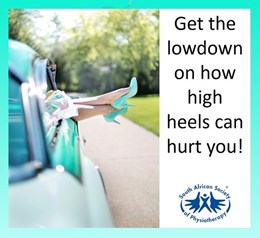
Get the Lowdown…
…on how high heels can hurt you
High heels (anywhere from 4 cm to 13 cm) have a wonderful impact on a woman’s appearance – but this comes at a price. “Nine out of ten people who wear high heels for extended periods of standing or walking, regularly report some pain or discomfort in their feet,” says Dr Ina Diener, president of the South African Society of Physiotherapy. And high heels greatly increase your risk of ankle sprains – the higher the heel, the greater the risk.
“But research shows that high-heels can cause problems for more than your feet and ankles. Scientists at the Faculty of Sports Science, at Ningbo University, in Zhejiang, China, reported in 2013 that regular wearing of high heels can contribute to osteoarthritis of the knee joint – a very painful condition.”
Last year, the June issue of the Journal of Foot and Ankle Surgery published a study of injuries recorded by US emergency departments. The finding? The number of injuries related to high-heeled shoes nearly doubled between 2002 and 2012, with those most at risk for injury being women aged 20-29, followed by women 30-39. (There was also an unexpected – to the authors – blip in the 0-9 year old group, who were probably wearing mommy’s high heels.) 72% were injuries to the ankle or foot but a remarkable 16.6% were injuries to the upper body. Almost half of the injuries took place at home, with most of the rest taking place on the street or on public property. “Apart from trips and twists, it’s likely the shift in the centre of gravity due to high heels unbalances women and makes them more prone to falls,” says Dr Diener.
Over the long term, regular use of high heels can shorten muscles in the calf, making it difficult to revert to low heels.
That means less options for walking and running, notes Dr Diener. “In National Physiotherapy BackWeek, from 5-11 September this year, physiotherapists are passing on the message that more movement is one of the best things you can do for your health. If you’ve hobbled yourself by wearing high heels too much, that’s going to be hard to do!” Ring the changes, she suggests: alternate days on high heels with days on low heels or even flats.
“Researchers have shown that the height most women feel comfortable with, the height that doesn’t fatigue muscles and disturb gait, is around two or three centimetres,” notes Dr Diener.
The warning is clear: wear low-heeled shoes around the home and for everyday use, especially when walking in the streets, parking garages and other public places.
High heels should be a treat, like red velvet cake, or a tiara: perfect for special occasions when you want to feel smart, sexy and feminine, not for daily walking and standing.
If your knees or hips hurt, contact your physiotherapist for an assessment, or phone the SASP on 011 615 3170 to find out where free assessments are happening during National Physiotherapy BackWeek 2016.
Back






